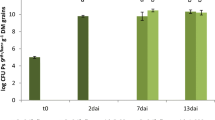Abstract
No evidence was found that mansonones E and F, which accumulated in elms after infection withCeratocystis ulmi, were responsible for resistance against Dutch elm disease inUlmus hollandica cl. 390. Furthermore, production of mansonones inU. americana was only about one-fifteenth of that inU. hollandica cl. ‘Belgica’. Yet both are susceptible to Dutch elm disease.
Induction of these compounds was not specific, for accumulation occurred not only after introduction of crude toxin ofC. ulmi, but also after inoculation withVerticillium albo-atrum and after introduction of H2SO4 or ethanol.
The dark discolouration of the wood after toxin treatment was restricted to the lower part of the stem. No mansonones could be detected in the non-discoloured higher parts of the stem or from the necrotic or wilted leaves.
Samenvatting
Er werd geen aanwijzing gevonden dat mansononen E en F, die na infectie metC. ulmi gevormd worden, verantwoordelijk zijn voor de resistentie tegen de iepziekte inU. hollandica cl. 390 (Tabel 1).
U. americana bevat ongeveer 15 maal zo weinig van deze stoffen alsU. hollandica cl. ‘Belgica’, terwijl beide vatbaar zijn.
De inductie van de synthese van deze stoffen bleek niet specifiek te zijn, omdat bij chemische beschadiging met H2SO4 of ethanol ook mansononen gevormd werden.
De donkere verkleuring van het hout bleek na toxine toediening beperkt tot het onderste gedeelte van de stam. Geen mansononen werden gevonden in hoger gelegen, niet verkleurde stamgedeelten of in de necrotische en verwelkte bladeren.
Similar content being viewed by others
References
Beckman, C. H., 1956. Production of pectinase, cellulases, and growth-promoting substances byCeratostomella ulmi. Phytopathology 46: 605–609.
Bell, A. A., 1969. Phytoalexin production and Verticillium wilt resistance in cotton. Phytopathology 59: 1119–1127.
Dimond, A. E., 1967. Physiology of wilt disease. In; C. J. Miraha & I. Uritan (Ed.), The Dynamic Role of Molecular Constituents in Plant-parasite Interaction, Am. phytopath. Soc. St. Paul, Minn. p. 100–120.
Dimond, A. E., 1970. Biophysics and biochemistry of the vascular wilt syndrome. Am. Rev. Phytopath. 8: 301–322.
Elgersma, D. M., 1969. Resistance mechanisms of elms toCeratocystis ulmi. Meded. Phytopath. Lab. Willie Commelin Scholten. 77: 1–84.
Elgersma, D. M., 1970. Length and diameter of xylem vessels as factors in resistance of elms toCeratocystis ulmi. Neth. J. Pl. Path. 76: 179–182.
Feldman, A. W., Caroselli, N. E. & Howard, F. L., 1950. Physiology of toxin production byCeratostomella ulmi. Phytopathology 40: 341–354.
Gagnon, C., 1967. Histochemical studies on the alteration of lignin and pectic substances in white elm infected byCeratocystis ulmi. Can. J. Bot. 45: 1619–1623.
Hodgson, R., Peterson, W. H. & Riker, A. J., 1949. The toxicity of polysaccharides and other large molecules to tomato cuttings. Phytopathology 39: 47–62.
Holmes, F. W., 1954. The Dutch elm disease as investigated by the use of tissue cultures, antibiotics, and pectic enzymes. Ph. D. Thesis, Cornell Univ., Ithaca, New York.
Lindgren, B. O. & Svahn, C. M., 1968. Extractives of elm wood. Phytochem 7: 1407–1408.
Overeem, J. C. & Elgersma, D. M., 1970. Accumulation of mansonones E and F inUlmus hollandica infected withCeratocystis ulmi. Phytochem 9: 1949–1952.
Rai, P. V. & Strobel, G. A., 1969. Phytotoxic glycopeptides produced byCorynebacterium michiganense. II. Biological properties. Phytopathology 59: 53–57.
Rebel, H., 1969. Phytotoxins ofCeratocystis ulmi. Isolation and structure investigation. Thesis, Utrecht, pp. 77.
Tchernoff, V., 1965. Methods for screening and for the rapid selection of elms for resistance to Dutch elm disease. Acta bot. neerl. 14: 409–452.
Author information
Authors and Affiliations
Rights and permissions
About this article
Cite this article
Elgersma, D.M., Overeem, J.C. The relation of mansonones to resistance against dutch elm disease and their accumulation, as induced by several agents. Netherlands Journal of Plant Pathology 77, 168–174 (1971). https://doi.org/10.1007/BF02000008
Accepted:
Issue Date:
DOI: https://doi.org/10.1007/BF02000008



